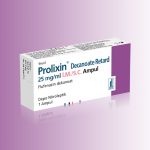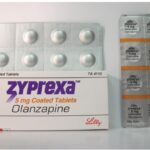Recommended Fluphenazine Dosage for People with Schizophrenia

Fluphenazine is an antipsychotic medication used to treat schizophrenia and psychotic symptoms such as hallucinations, delusions, and hostility. Schizophrenia is a chronic, severe mental disorder that affects the way a person thinks, acts, expresses emotions, perceives reality, and relates to others. Though schizophrenia isn’t as common as other major mental illnesses, it can be the most chronic and disabling.
People with schizophrenia often have problems doing well in society, at work, at school, and in relationships. They might feel frightened and withdrawn and could appear to have lost touch with reality. This lifelong disease can’t be cured but can be controlled with proper treatment.
According to the World Health Organization, Schizophrenia affects approximately 24 million people or 1 in 300 people (0.32%) worldwide. This rate is 1 in 222 people (0.45%) among adults. Although it affects barely 1% of the US population, it is one of the most disabling diseases affecting humankind. Schizophrenia is a chronic and severe neurological brain disorder estimated in 2014 to affect 1.1 percent of the population or approximately 2.6 million adults in the United States aged 18 or older.
Fluphenazine is a widely available and low‐priced antipsychotic drug that has been used for decades. It belongs to the first generation (typical) antipsychotic drugs. It was approved as an antipsychotic by the US Food and Drug Administration (FDA) in 1959. It was first used in Britain for anxiety until American studies indicated its potential in managing psychotic illness.
However, the fluphenazine brand Prolixin is discontinued but generic brands of fluphenazine remain widely available in the market.
How should this Fluphenazine (Prolixin) be used?
Fluphenazine comes as a tablet or oral liquid (elixir and concentrate) to take by mouth. It is usually taken two or three times a day and may be taken with or without food. Follow the directions on your prescription label carefully, and ask your doctor or pharmacist to explain any part you do not understand. Take fluphenazine (Prolixin) exactly as directed. Do not take more or less of it or take it more often than prescribed by your doctor.
Fluphenazine oral liquid comes with a specially marked dropper for measuring the dose. Ask your pharmacist to show you how to use the dropper. Do not allow the liquid to touch your skin or clothing; it can cause skin irritation. Dilute the concentrate in water, Seven-Up, carbonated orange beverage, milk, or V-8, pineapple, apricot, prune, orange, tomato, or grapefruit juice just before taking it. Do not use beverages containing caffeine (coffee, tea, and cola) or apple juice.
Continue to take fluphenazine (Prolixin) even if you feel well. Do not stop taking fluphenazine without talking to your doctor, especially if you have taken large doses for a long time. Your doctor probably will want to decrease your dose gradually. This drug must be taken regularly for a few weeks before its full effect is felt.
What is the recommended fluphenazine (Prolixin) dosage for People with schizophrenia?
According to studies, the usual fluphenazine (Prolixin) initial oral doses range from 0.5 to 10 mg/day, which is divided and given every six to eight hours. As for maintenance, a daily dose of 3 mg is rarely necessary. Once symptoms have been controlled, the dosage should be gradually reduced to a daily maintenance dose of 1.0 to 0.5 mg which can often be administered as a single daily dose. Parenterally, fluphenazine’s initial dose ranges from 2.5 to 10.0 mg/day intramuscularly (IM) divided dose to be given every six to eight hours.
The full breakdown of fluphenazine dosage is presented below:
Usual Adult Dose for Psychosis
Oral:
- Initial dose: 2.5 to 10 mg orally in divided doses every 6 to 8 hours
- Maintenance dose: 1 to 5 mg/day
- Maximum dose: Up to 40 mg/day
Oral Comments:
Maintenance doses may be given as single daily doses.
Many patients achieve a therapeutic effect with doses of less than 20 mg. Patients who are severely disturbed or inadequately controlled may require a dose of up to 40 mg/day.
Parenteral:
Fluphenazine Decanoate for Injection:
- Initial dose: 12.5 to 25 mg deep IM injection into the gluteal region
- Maintenance dose: 12.5 to 100 mg IM, usually every 3 to 4 weeks
- Maximum dose: 100 mg/injection
Fluphenazine HCl for Injection:
- Initial dose: 2.5 to 10 mg IM, given as divided doses every 6 to 8 hours
- Maximum dose: Up to 10 mg/day
Parenteral Comments:
Patients may switch from Fluphenazine HCl for Injection to oral formulations when symptoms are controlled. The dose of an oral formulation is approximately 2 to 3 times the dose of fluphenazine HCl for injection.
Fluphenazine decanoate for injection may be given subcutaneously.
Uses:
- Management of manifestations of schizophrenia
- Management of patients requiring prolonged parenteral neuroleptic therapy (e.g., patients with chronic schizophrenia)
Usual Geriatric Dose for Psychosis
Oral:
- Initial dose: 1 to 2.5 mg orally, given in divided doses every 6 to 8 hours
- Maintenance dose: 1 to 5 mg/day
- Maximum dose: Up to 40 mg
Comments:
- Maintenance doses may be given as a single dose.
- Many patients achieve therapeutic effects with doses less than 20 mg. Patients who are severely disturbed or inadequately controlled may require a dose of up to 40 mg/day.
Use: Management of manifestations of schizophrenia
What are the likely side effects of Fluphenazine?
Fluphenazine side effects include:
• drowsiness,
• lethargy,
• dizziness,
• nausea,
• loss of appetite,
• sweating,
• dry mouth,
• blurred vision,
• headache, or
• constipation.
Tell your doctor if you have serious side effects of Prolixin (fluphenazine) including:
• feelings of restlessness,
• mask-like facial expression,
• greatly increased saliva,
• tremors,
• unusual mental/mood changes (such as depression, worsening of psychosis),
• confusion,
• unusual dreams,
• frequent urination or difficulty urinating,
• vision problems,
• weight changes,
• swelling of the feet or ankles,
• fainting,
• skin discoloration,
• butterfly-shaped facial rash,
• joint pain, or
• seizures.





